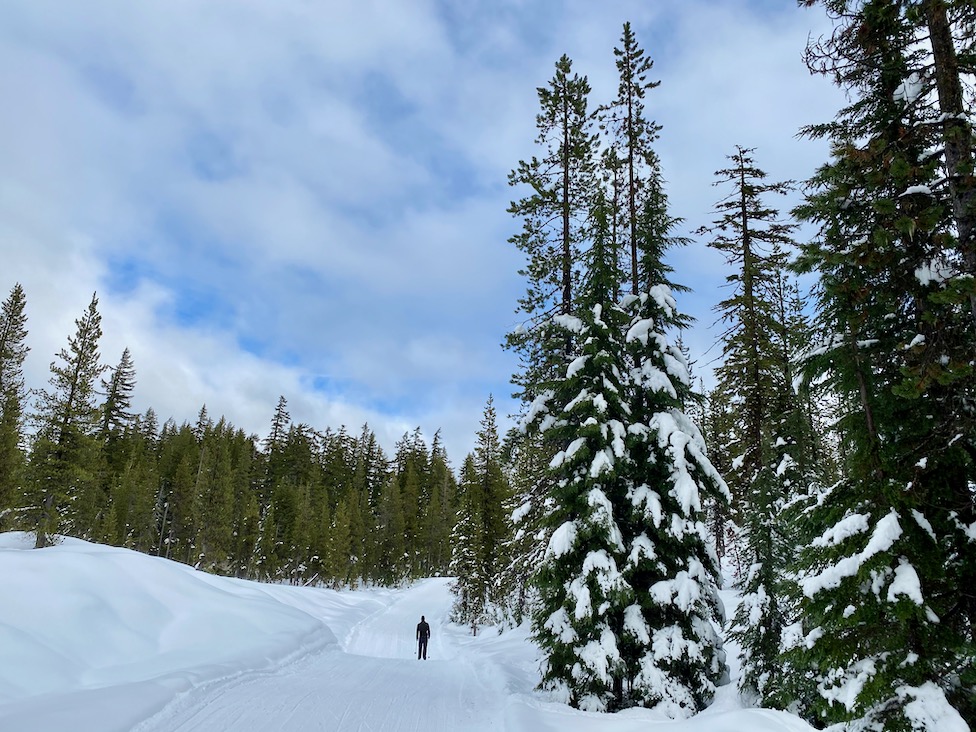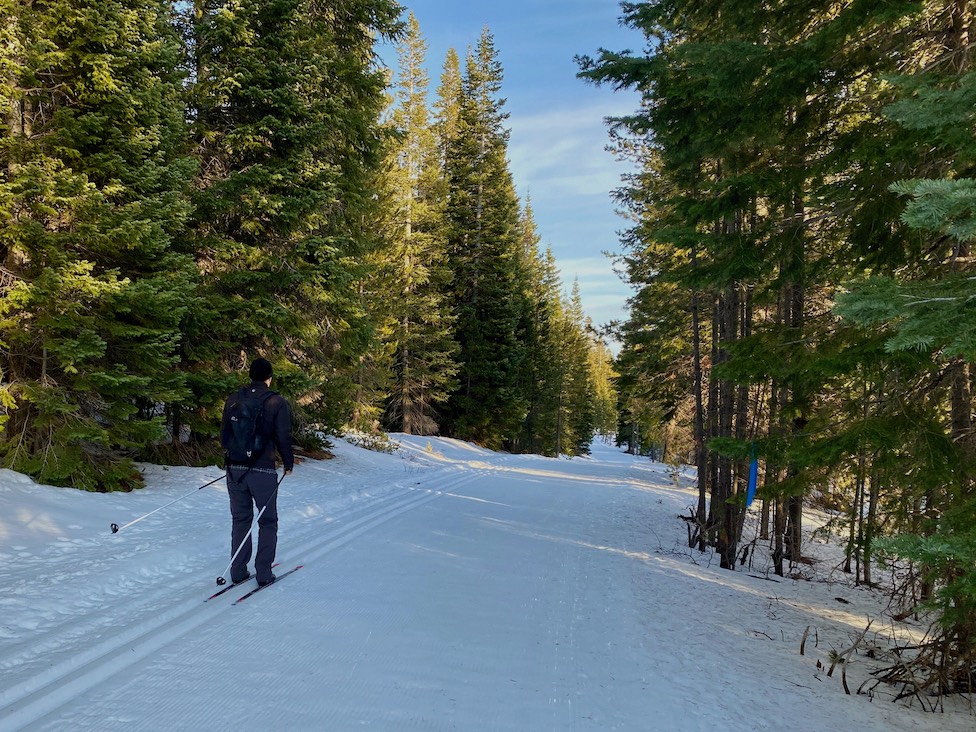Local cross-country skiing can smooth a bumpy winter’s ups and downs
The Washington Post
By Erin E. Williams
January 7, 2021
In Bend, Ore., winter arrived early this year, bringing a three-foot base to the Cascades by late November — as well as antsy Nordic skiers who pounced on the snow when the first flakes fell.
Awaiting them was Sunnyside Sports. Concerned with keeping its customers and staff safe yet wanting to help the community get outside, in October the local bicycle and cross-country ski shop decided to forgo daily ski rentals and instead offer season-long leases. Its rental stock was cleaned out by the following day.
As the pandemic grinds on and restrictions and winter worsen cabin fever, traversing our nearby trails brings essential mental and physical health benefits; cross-country skiing allows us to discover outdoor areas, enjoy nature and exercise while maintaining distance. And it’s remarkably accessible, since you can ski nearly anywhere there’s snow.
I also jumped on the season, taking advantage of this winter’s storms to explore cross-country ski areas along part of the Cascade Lakes National Scenic Byway, which snakes into the mountains near my house in Bend. Several winter recreation areas flank the route, providing easy access to miles of skiing and snowshoeing trails in the Deschutes National Forest — as well as dazzling panoramas of surrounding peaks and volcanic landscapes.
Only 15 miles from town, nonprofit Meissner Nordic Ski Club partners with the Forest Service to operate about 25 miles of community trails at Virginia Meissner Sno-Park. Here, I found my snow legs on less-traveled routes that curved white ribbons through the conifers, then shared wide, perfectly groomed main tracks with other skiers. A few miles farther up the highway, my tracks intersected with wild critters’ footprints at Swampy Lakes Sno-Park, where the Central Oregon Nordic Club maintains trails with the Forest Service. And I swooped down gentle hills on an approximately 9,000-foot mountain; Mt. Bachelor, the United States’ sixth-largest ski resort, boasts approximately 35 miles of groomed Nordic trails and a season that can stretch into June.
Like other resorts, Mt. Bachelor is navigating an unprecedented winter in accordance with state and local health guidelines. Its “back to basics” approach includes online parking reservations and a requirement that visitors purchase passes, rentals and lessons before arrival. Food is grab-and-go at the lodge and food carts. Lodge and Nordic Center capacity is limited, with masking, one-way flow and distancing measures. For downhill skiers and snowboarders, lift access is distanced, with no requirement to ride with strangers; as usual, Nordic skiers don’t use the lifts.
According to Mt. Bachelor, this year’s season pass sales and parking reservations reflect a pent-up need for outdoor activities that lend themselves to distancing. The Professional Ski Instructors of America and the American Association of Snowboard Instructors (PSIA-AASI) also forecast an uptick in cross-country skiing this winter.
“There’s definitely been a noticeable increase in demand,” said former Nordic ski racer Jeff Neagle. He has worked in the ski industry for 15 years, including the last five at Pinnacle Ski and Sports in Stowe, Vt. At this family-owned shop and its online storefront SkiEssentials.com, year-over-year cross-country ski sales skyrocketed more than 700 percent in November, Neagle said.
That’s heartening news for snow-sport businesses — and for people who are discovering their nearby trails, since the activity can help initiate and maintain longevity-boosting behaviors.
“Cross-country skiing is low impact and weight-bearing, and its cardiovascular benefits are significant because you’re using so many muscle groups,” said Paul Anderson, a Nordic skier and occupational medicine physician at Minnesota-based HealthPartners. He researches cross-country skiers’ relationship with healthy practices. Participants tend to be interested in movement, eating well and avoiding unhealthy habits — and they support other community members’ exercise, Anderson found.
“It also gets people into nature, which can help address anxiety and depression,” he added. “Nature and outdoor therapy are becoming more widely understood as important components of mental health care.”
Kick and glide or shuffle
The sport has a lower entry barrier than its downhill cousin, which has steeper slopes and learning curves. Cross-country, a type of Nordic skiing, has its own variations, including classic: the most popular and beginner-friendly method, which involves kicking and gliding forward with parallel skis, mimicking a walking rhythm.
“The best thing about cross-country skiing is that you can do it however you want,” said Neagle. “There’s not really an increased risk of injury if you’re going slow, and it’s a great workout whether you have existing technique or are figuring it out on your own.”
According to Anderson, short outdoor lessons (where people are typically masked and distanced) can help students learn technique and how to handle gear. PSIA-AASI provides snow-sports school and instructor referrals, online guides for every level and even individual virtual instruction through a partnership with coaching tool Givego — which directly connects users with the country’s top instructors. Nordic Ski Lab’s and REI’s videos can also help develop skills at home, from stepping into bindings to getting up after a tumble.
“The goal is to have fun, so don’t get too hung up on whether or not you’re doing it right,” Neagle added. “Rather than focusing on the perfect technique, just enjoy shuffling around and growing your skills as you move forward.”
Find your trail
According to the Cross Country Ski Areas Association (CCSAA), which maintains an online directory, there are more than 350 cross-country ski areas in the United States and Canada. Many are within an hour’s drive of cities. Some are resorts like Mt. Bachelor that offer Nordic and downhill skiing, and others are Nordic-specific centers. Other locations include stand-alone trail systems, parks and golf courses. Some groom their trails, and light touring on ungroomed terrain is sometimes available. Many locations have trail maps online; beginner trails are marked green.
Staying local this season can keep skiers safer and avoid possible closures, shutdown restrictions, nonessential travel advisories and travel quarantines (even for weekend skiers).
In D.C., opportunities abound as close as Rock Creek Park. Maryland has a flurry of options, and West Virginia has trails in national forests, state parks and the White Grass Touring Center. Online, DCSki.com features stories, interviews and a community forum regarding snow sports throughout the Mid-Atlantic.
Bundle up
Part of cross-country skiing’s appeal is that cost won’t necessarily freeze out participants. With many free or low-cost local ski areas, access can be affordable. Gear rental is typically inexpensive, and some ski shops offer local delivery. In Bend, Mt. Bachelor offers one-day packages for $35 as well as seasonal leases. Sunnyside Sports priced its rental packages for a rock-bottom $50 to $75 for the winter.
“When push comes to shove, we’re here to serve,” said Sunnyside Sports co-owner Susan Conner, who wanted to open the door for those who might have missed outdoor experiences this winter. “We’ve tried to continue to operate weighing how we can keep people safe while getting them outside.”
Some local shops and online retailers also sell complete packages that eliminate guesswork for novice enthusiasts. Each package usually bundles skis, bindings, boots and poles; size charts are simple, with ski length based on body weight. Beginner- and intermediate-friendly recreational packages start at around $300 to $500.
“Anything in that price range will be designed to do a little bit of everything, whether you’re skiing at a Nordic touring center or making your own tracks,” Neagle said. “And it allows you to go out your front door and have a little adventure.”
Since the sport is endurance focused, attire is lighter than alpine outerwear: usually a sweat-wicking base and mid-layers and a breathable, wind-resistant jacket. Bottom options include thermals and running tights, or fleece or soft-shell pants.
Questions? Call your nearby shop, which can help customers select, size and maintain gear. Whether by phone, online or in person when it’s safe, these businesses offer expert advice about local terrain and connection with the ski community. Ski associations are also resources for getting people outside, teaching skills and managing trails; American Cross Country Skiers has an online list of these groups.
Adventure safely
This season, participants should avoid pre- and post-ski gatherings. Distancing and masks are important anywhere people might have closer contact, including warming huts that haven’t already shuttered to reduce risk. Anderson advised that even outdoors, skiers should distance, maintain proper hygiene and exercise caution skiing for an extended time near anyone outside their household.
Wherever you adventure, be considerate of other people and private land, heed trail signs and follow Leave No Trace practices.
Original at The Washington Post.




